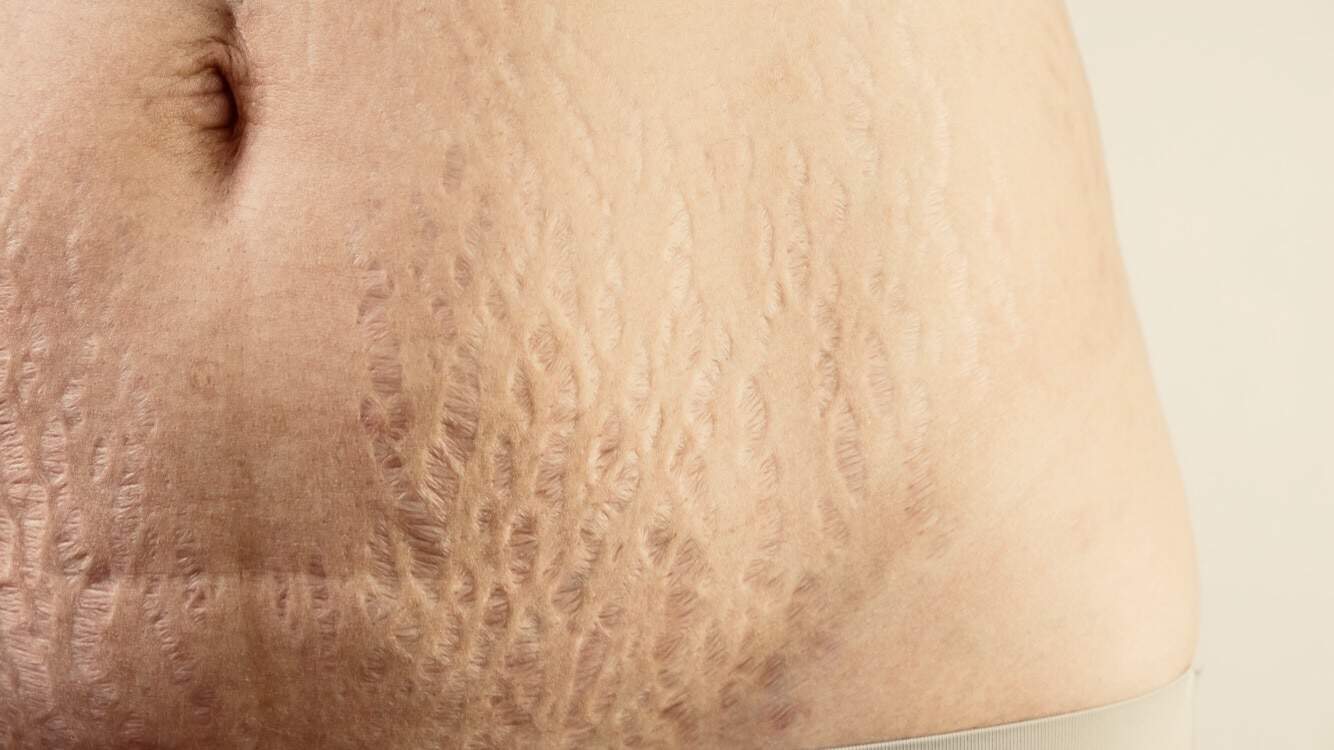Stretch marks are thin lines that form on the skin following a period of “intense growth,” such as pregnancy, puberty, weight gain, and weight loss. Pregnancy appears to be the leading cause of stretch marks. Per a study published in the Journal of the American Academy of Dermatology, between 52 to 59 percent of pregnant women develop stretch marks while carrying. Some estimates are much higher, citing as high as 90 percent.
Other factors that may increase the risk developing stretch marks include:
- the use of steroids
- genetic predisposition (e.g., for thinner skin)
- hormonal imbalances
- undergoing breast enhancement surgery
- medical conditions (e.g., Marfan syndrome and Cushing’s syndrome.)
- prolonged use of corticosteroids
- chronic diseases
- obesity
The abdomen, breasts, buttocks, flank, hips, and thighs are the most commonly affected areas. Stretch marks are not dangerous to physical health and often fade in appearance without medical intervention. However, stretch marks may cause emotional or psychological effects such as anxiety and/or low self-esteem.
Despite the attempts of the pharmaceutical industry to cash in on the prevalence of stretch marks, there is little to no evidence suggesting topical (medicine applied onto the skin) treatment of the condition is effective.
While there is currently no “proven” treatment for stretch marks, they can be prevented or easily covered up. Again, stretch marks are not associated with any known medical condition. They are solely cosmetic in nature.
(Note: It is worth mentioning here that anecdotal accounts of some skin products do seem promising. That is, a particular product may indeed work for certain people; this includes the application of vitamin E products, as well as pharmaceuticals. The “problem” is that medical studies demand both observable and measurable differences for many people to deem a treatment “effective.”)
How to Prevent Stretch Marks
Even though (stretch marks) never really go away, they might fade over time or with help from certain products and procedures.” – WebMD
Here are a few ways to prevent the development of stretch marks:
- Exercise: Rapidly gaining weight is one of the leading causes of stretch marks. Exercise along with proper diet (see below) can go a long way in preventing unwanted alterations to the skin’s appearance.
- Eat a balanced diet: Along with getting proper exercise, make sure to eat a diet with the right mix of healthy fats, protein, and non-refined carbohydrates.
- Get your healthy fats: Consuming healthy fats (poly- and mono-unsaturated) is a sure way to improve your skin’s appearance. Fatty fish, avocados, and walnuts are three favorites.
- Avoid “yo-yo dieting”: As mentioned, it is the rapid fluctuation of weight (fat gain and fat loss) that is mostly to blame for stretch marks. Instead of gaining weight, dieting, and repeating the cycle, resolve to eat healthily every day.
- Hydrate: The skin is made up of 64 percent water, so drinking 8 to 10 glasses of H2O per day will surely promote skin health. Beyond the skin, proper hydration aids both the digestion and transportation of nutrients, which helps the body eliminate waste, maintain a healthy weight, and normalize the metabolism!
How to “Get Rid” of Stretch Marks
As discussed, stretch marks will generally fade on their own. Getting plenty of water, eating a healthy diet, and working out regularly will make these marks go away faster. And while there is no quick fix to get rid of them, there are ways to make stretch marks less visible. One popular option for improving the appearance of stretch marks is Microneedling Arlington, a treatment that can help stimulate collagen production and reduce the visibility of stretch marks over time.
Here are a few ideas:
-
Try a coffee, honey, and sugar scrub
A natural ingredient home scrub may be just what the doctor ordered. There are plenty of homemade skin scrubs out there, but coffee and sugar, because they are abrasive, may be the best option. Honey is a wonderful anti-inflammatory and moisturizer, which makes its addition to any homemade scrub a must.
-
Consider laser therapy
Bad news first: most insurance plans will consider laser therapy for stretch marks a cosmetic procedure and, because of this classification, will not cover any of the expenses. Good news: laser therapy is getting much cheaper, safer, and more effective.
-
Skin pigment tattoo
Okay, so you’re going to need to find an excellent tattoo artist to pull this off. But if you can find one that’s good enough, they can closely match your skin pigmentation with an available ink. Needless to say, you don’t want to go cheap here.
-
Get a regular tat
A tattoo can be a real work of art. Seriously, there are some absolutely gorgeous designs that, when inked on with capable hands, can look stunning. Discuss this option with a reputable artist in your area.
-
Speak with a dermatologist
While research on the efficacy of stretch mark treatments is inconclusive at best, dermatological procedures such as microneedling improve all the time. You may want to consult a dermatologist for advice in this domain. Dermatologists are licensed physicians specializing in the diagnosis and treatment of skin disorders. (Just make sure to do your own research as well.)



















